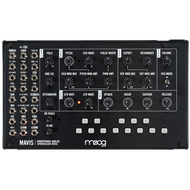Mavis - Moog
by Sam Chittenden
Mavis is Moog’s latest semi-modular offering. Like a love child between the Werkstatt and the Mother-32, Mavis is offered as an unassembled kit [think put-it-together, rather than DIY since there’s no soldering involved.] It is a relatively low-cost entry in the Moog line-up and while it is positioned as an “introductory” synth it packs the famous Moog punch and has a deceptively deep feature set packed into its small footprint.
Mavis arrives in thoughtfully designed packaging with a beautifully laid out and easy to follow instruction poster, along with a handful of patch cables and some patch diagram overlay cards similar to ones that come with the DFAM or Mother-32. Mavis also comes with a cover, a nice touch. I love that the Mavis comes with a cover as it makes it that much easier to take along as part of a live rig. Actual assembly of the Mavis is easy enough and only requires screwing the faceplate onto the already-populated circuit board and into the provided desktop enclosure. Mavis can also be mounted in a Eurorack case if so desired. The trickiest bit of the build is harnessing the patience required to screw on all 24 of the patchbay’s hex nuts. Handily, Moog provides a small nut wrench, and while it won’t grant you more patience, it does help wrangle those jack nuts into place. The included plastic enclosure and lid fit well together, the brushed metal faceplate is nice, the mini pots are surprisingly sturdy, and the patch points solid, and once it’s all put together Mavis feels solid and substantial.
Mavis is monophonic, though with its flexible patch bay can be used duophonically, and features a [mostly classic] set of features. An all-analog affair, there are no menus or key-combos to remember here, just one each of a VCO, VFC, VCA, LFO, an ADSR envelope, a 24-point patch bay and a small rubber chiclet-style keyboard. The big swerve is Mavis’ wavefolder —a first for Moog —and a welcome sprinkling of West Coast paradigm that really adds to Mavis’ character and potential.
Mavis’ single oscillator is nice and beefy, with controls for pitch, wave shape [morphable from sawtooth to pulse], and pulse width. The VCO also has modulation controls for pitch and PWM and a normalled modulation source can be blended between the LFO and the envelope generator. The filter is a classic Moog 24-db low pass ladder filter, complete with low end drop when the resonance is increased. It will self-oscillate and —no surprise here—sounds excellent. The LFO will run up to audio rates and its waveform can be blended between a triangle and square wave. The VCA can be controlled by the envelope generator or set fully open to allow the synth to drone on, and also has a dedicated volume knob [for overall output levels]. The onboard keyboard is a nice touch, and while it doesn’t provide much of a playing experience, it’s a fun tool to have available for sequence transpositions, manual modulation, and other patch specific functions. The keyboard scale knob also allows you to adjust the intervals between the keys, giving you more options for performative scaling. Last but not least is the inclusion of the wavefolder, which provides even more timbral range straight out of the gate.
Out of the box Mavis gives some great timbres based only on its normalled connections but it really comes alive once you start patching. Mavis’ patchbay is the key to the rich and varied sonic exploration that Mavis offers. Along with patch points for 1V/oct pitch control, pwm, filter cutoff, gate for the envelope circuit, and CV control over the VCA, Mavis’ patchbay has a sample and hold circuit, a DC-coupled mixer with offset control, a mult, and an attenuator. The utilities within the patchbay are connected with a small utility section which includes the wavefolder circuit, an offset/level control, and the attenuator pot. This clever suite of utilities really provides Mavis with a surprising depth, playability, and sonic variety without having to include any other equipment in your set-up. Putting the LFO to work as a second oscillator opens up Mavis for duophonic melodies and ripping cross-modulated timbres. The wavefolder, which unfortunately is strictly under manual control, sounds great when working on the more mellow triangle wave of the LFO, and blending between the primary VCO and wave folded LFO is all sorts of fun. Cranking up the resonance on the filter and cross patching between the VCO, LFO, and envelope conjures up a forest world of insane bird chirps and bubbling resonant goodness. Mavis can patch up a nice punchy kick as well, with the wavefolder helping to dialing in the dirt.
With so much to explore on Mavis, it’s great that Moog has included several patch overlays to get started with exploring Mavis’ sounds. For even further exploratory tips there are a wealth of resources available to download from the Moog website, including demonstration videos and patchbooks for exploring Mavis alongside Moogs other semi-modular offerings. As an intro-to-synths synth Mavis is fantastic and, maybe not surprisingly, is fantastic for experienced users as well. With a straightforward interface, a cleverly designed set of patchbay offerings, and an undoubtable pedigree, there is much to be had in exploring Mavis and all it has to offer. A great sounding, powerful, and most importantly, fun synth at a price that is hard to beat? What’s not to love? Highly recommended.
Price: $349


